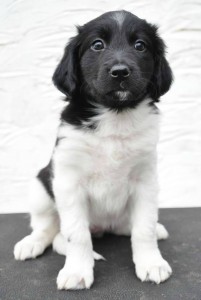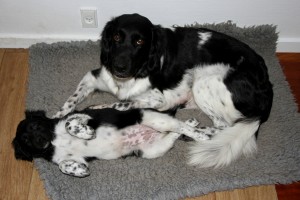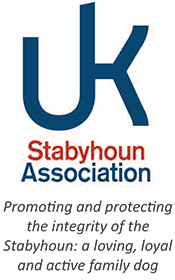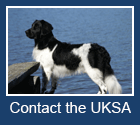
Imke, born in the North West in 2016
Careful and well-managed breeding of the Stabyhoun is extremely important. The goal of the UKSA is to protect the unique characteristics of the Stabyhoun. We do not endorse breeding that seeks to enhance the appearance of this wonderful dog to succeed in the show-ring, at the expense of healthy genetic diversity.
If you are potentially interested in breeding with your Stabyhoun, please let us know in your Puppy Application. If you are buying a puppy, don’t be afraid to ask your breeder if they have followed the appropriate rules and taken the necessary steps to help protect the breed. By only purchasing puppies from responsible breeders, you will be doing your bit to ensuring the future of this wonderful dog.
Stabyhouns are bred out of love for the breed – not financial profits. That means that these dogs live in people’s homes and not in outside kennels. For the puppies, they have the joy and benefits of being raised and socialised in a home environment right from birth.
UK Stabyhoun Association breeding guidelines
Great care is and must be taken when breeding with the Stabij. With a global population of just a few thousand, every single litter of puppies is important which is why many breeders encourage further but careful breeding of the best puppies in each litter.
The following rules are laid down for anyone wishing to breed from a Stabyhoun in the UK. The aim is to preserve a healthy population of dogs from a genetically diverse background. Every mating must have been approved by the UK Stabyhoun Association Breeding Advisory Committee following a review of the health and ancestry of both dogs. Factors such as the individual health, temperament, build and heritage of both dogs will be taken into account before any request is approved. Breeding requests are considered on an individual basis, in light of the requirements below.
Only dogs of good health should be bred from, and each combination must be approved by the UKSA Breeders Advisory Committee. We do, however, recognise the importance of breeding from a broad range of dogs for the purpose of maintaining genetic diversity. Our breeding regulations are formulated to limit genetic drift, spread out the use of available genes and to monitor health and temperament in resulting litters.
1. Breeders must actively work to keep breed specific traits, qualities and attributes of the Stabyhoun according to the official Dutch and FCI recognised breed standard.
2. At the time of the mating, the female must be over the age of 2 years old and the male above the age of 18 months. Bitches must be no more than 5 years old at the time of their first litter.
3. While such a small population exists in the UK, no bitch or dog should be mated further once their 21st puppy has been born.
4. Bitches must have been mated for the last time before they reach the age of 8.
5. All UK breeding dogs must have been tested for Cerebral Dysfunction (carriers are allowed to breed with non-carriers)
6. At least one clear calendar year should pass from first mating until a bitch is mated a second time. 50% of her first litter should have been formally evaluated before a second mating is approved. For males, 1 planned litter is permitted in a 12 month period, with a 2nd litter only permitted under exceptional circumstances. 50% of his first (and second if applicable) litter should have been formally evaluated before further matings are approved.
7. Before a Stabyhoun is allowed to breed, he or she must have passed two formal assessments by a judge who specialises in evaluating the Stabyhoun: the first from the age of 9 months and the second not before the age of 15 months.
8. Genetic diversity must be encouraged and as such, the same stud dog must not be used more than once on the same bitch.
9. The inbreeding coefficient (COI) of the proposed litter must be as low as possible, but always considered in context of other health factors.
10. Hip scores of A (10 in total) and B (25 in total) are considered an automatic ‘pass’. Elbows of 0 and 1 are allowed but dogs with 1 point on one or both elbows must be mated to dogs with a 0-0 elbow score. Dogs with C-hips will be considered on a case by case basis – taking into account their genetic value to the population, the score of each hip and the difference in scores e.g. a score of 8-18 is less desirable than 12-12 which is a more even score and fewer faults per hip. Dogs with C-hips will only be allowed to mate with dogs that have A-hips, and following approval from the UKSA Breeding Advisory Committee who will review and consider the full history of hip scores in the parentage of both dogs.
In the UK, hip and elbow scores are carried out by your vet and the British Veterinary Association. You can read more about their health schemes and find a local expert by clicking here.
A hips: 10 in total with no one hip scoring higher than 6
B hips: 25 in total with no one hip scoring higher than 14
C hips: 26-35 in total with no one hip scoring higher than 18
11. A DNA test with Embark must be carried out prior to breeding. The results are used to determine von Willebrand risk factors, as well as more in depth inbreeding information.
Breeders who do not adhere to the UKSA Breeding Regulations may have their membership to the UKSA rescinded, as written in the UKSA Code of Ethics

Jelske and her daughter M
Stud fees
The fee for using a UK male Stabyhoun stud is an agreement and contract between the owner of the male and the female. Typically, it is the equivalent of the price of a puppy although the total fee and when it is paid can vary. A stud dog agreement should be made between both parties before the mating – setting out options for a second mating if the first is unsuccessful, who pays for AI if necessary and more. The UKSA provides a contract which allows both parties to tailor an agreement to suit them, and the club is happy to advise on the various options and current practice.
Selling UK-born Stabyhoun puppies
The UK Stabyhoun Association operates a central waiting list of families that have been through our application process. To make sure these wonderful puppies all have loving homes to go to with families that understand the need of the bred, Stabyhoun puppies in the UK are sold via the UK Stabyhoun Association. Should there be very few or no families at all on our waiting list at the time of a planned mating, the breeder will be advised to consider postponing (this is yet to happen!). Getting a dog is a big decision and making sure puppies are sold to loving homes that have the necessary time and commitment will help prevent these dogs ever having to be re-homed.
Registration of puppies
All puppies born in the UK and those that are imported from the Netherlands are pedigree registered by the Dutch Kennel Club (Raad van Beheer). This was made possible following a change in their by-laws in December 2014. All Stabyhoun globally are also registered in the database for the breed, ZooEasy with comprehensive health and conformation details. Keeping a complete record of all our dogs enables those who work for the preservation of the breed to monitor the health and well-being of the Stabyhoun as a whole.
Understanding progesterone testing
Good progesterone testing helps breeders decide the ideal time to mate the dogs. Too early and the female won’t have ovulated (which means she won’t get pregnant) and probably won’t stand willingly. Too late and her fertility drops dramatically – making pregnancy unlikely (and Artificial Insemination worth considering). An experienced vet will help guide you through the process, as will the UKSA. Don’t listen to ‘normal’ people’s advice about when the best time to mate your dog is – the ideal time varies hugely from day 6 to day 28! Only careful progesterone testing on YOUR dog during THIS heat cycle will give you the right answer.
The figures below are a guide to the progesterone test results. Ideally, you want to keep testing until you can be confident that ovulation is absolutely impending or has already occurred (this could be every day for a few days if you want to be sure). A result of 15 nmol/L or higher is what you’re looking for. Optimal fertility is between 30-65 nmol/L at the time of breeding.
0-2 nmol/L: Very early days
3 – 6 nmol /L: Minimum 2 days before ovulation expected but this level could persist for much longer
7 – 12 nmol/L: Minimum 1 day before ovulation. Estimated window for breeding 3 – 5 days but could be longer ( re-test)
13 – 18 nmol/L: Ovulation impending or just occurred. Estimated breeding window 2 – 4 days
19 – 31 nmol/L: Ovulation recently occurred. Estimated breeding window 1 – 3 days
32 – 64 nmol/L: Ova have matured, optimal potential for fertility. Estimated breeding window 0 – 2 days
65 – 90 nmol/L: Ova have matured but aging, decreased potential for fertility. Breed at once! Or consider Artificial Insemination.
Above 90 nmol/L: Too late
What to feed your pregnant dog?
A lot of UK Stabyhoun owners feed their dogs a high-quality diet of raw meat, offal, vegetables and bone (BARF). The following article provides a simple and sensible guide to feeding a pregnant dog along those same principles.








